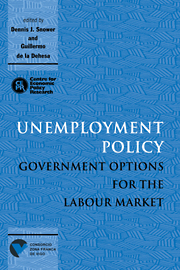Book contents
- Frontmatter
- Contents
- List of figures
- List of tables
- Preface
- Acknowledgements
- List of conference participants
- 1 Introduction
- PART ONE GENERAL POLICY ISSUES
- PART TWO DEMAND MANAGEMENT AND SUPPLY-SIDE POLICY
- PART THREE SUBSIDISING EMPLOYMENT AND TRAINING
- PART FOUR LABOUR MARKET REGULATIONS
- PART FIVE POLICY, JOB REALLOCATION AND THE UNEMPLOYMENT–PRODUCTIVITY RELATION
- 14 Is there a trade-off between unemployment and productivity growth?
- Discussion
- 15 Gross job reallocation and labour market policy
- Discussion
- Discussion
- PART SIX COMPARING UNEMPLOYMENT POLICIES
- Index
Discussion
Published online by Cambridge University Press: 07 September 2010
- Frontmatter
- Contents
- List of figures
- List of tables
- Preface
- Acknowledgements
- List of conference participants
- 1 Introduction
- PART ONE GENERAL POLICY ISSUES
- PART TWO DEMAND MANAGEMENT AND SUPPLY-SIDE POLICY
- PART THREE SUBSIDISING EMPLOYMENT AND TRAINING
- PART FOUR LABOUR MARKET REGULATIONS
- PART FIVE POLICY, JOB REALLOCATION AND THE UNEMPLOYMENT–PRODUCTIVITY RELATION
- 14 Is there a trade-off between unemployment and productivity growth?
- Discussion
- 15 Gross job reallocation and labour market policy
- Discussion
- Discussion
- PART SIX COMPARING UNEMPLOYMENT POLICIES
- Index
Summary
In recent years, interest in employment reallocation has grown, motivated both by policy concerns over job creation and by the availability of new data. Much of this recent literature, however, has been country-specific, and has focused primarily on the issue of whether job reallocation is driven by structural or cyclical forces. In chapter 15, Pissarides et al. break away from this single-country focus, and attempt to do some comparative analysis. They carry out a brave exercise of trying to extract conclusions from 10 data points. Their attempt to do cross-country work should be applauded; unfortunately, one ultimately learns very little from this exercise. Let me elaborate why.
I would like to make two basic points. The first relates to the quality of the data used, the second to the adequacy of the empirical framework.
Comparability of the data
Chapter 15 relies exclusively on the comparison of job reallocation rates across several OECD countries. Looking at the data used to calculate these rates, it becomes obvious that there are many potential comparability problems. For one thing, the samples vary significantly across countries, which matters because of the extreme cyclical sensitivity of job reallocation rates. For example, whereas for some countries the sample corresponds to the expansionary 1984–9 period, for others (Belgium) it refers to the recessionary 1980–3. Yet for others, e.g. Finland, it corresponds to 1986–9. Periodicity of the data also varies: sometimes they are annual, at other times biannual.
- Type
- Chapter
- Information
- Unemployment PolicyGovernment Options for the Labour Market, pp. 495 - 498Publisher: Cambridge University PressPrint publication year: 1997



